

Plan confidently, close faster, and report accurately with Planful.
Planful’s robust financial performance management platform empowers teams like yours to achieve peak financial excellence across every corner of your business.
What sets Planful apart? With quick implementation and minimal IT involvement, you can get started in weeks, ensuring seamless engagement across your organization’s key financial processes.
Grow without limits with a platform that scales with you, no matter how fast you expand.
Join over 1,500 global customers who trust Planful for flexible, user-friendly, end-to-end financial performance management. Ready to get started?
Below My Line

Blackstone and Vista Equity Partners agreed to take Smartsheet private for $8.4 billion this week. While some are speculating this was a direct result of interest rates dropping to a level that pushed the deal “above their line,” I have to believe, despite the sleepless nights bankers put in, this was in the works for a while.
Nonetheless, it’s a good omen for those who pray for rain.
Operators should be aware that companies who were once “not in play” to either be acquired or go public are starting to enter a zone “above the line”.
As debt becomes cheaper to finance large buyouts, like that of SmartSheet, which will inevitably be levered to the gills post acquisition, riskier tech companies looking to make a move into the public markets also become increasingly attractive to investors with each 50 bp drop.
We may see a bit of a switcheroo happening – more companies being taken off the NASDAQ and NYSE right as new ones join.

The Information said
“Score one for those deal-starved bankers out there.”
I’d rephrase it to
“Score one for the tech operators looking for liquidity.”
This deal certainly represents signs of life.

There haven’t been many opportunities for operators to sell their illiquid private company shares, with the IPO market frozen + many boards putting the breaks on any sort of trading activities (which would force them to officially accept a lower valuation on common shares). But as interest rates continue to fall, we should enter a Goldilocks zone, thawing the appetite for movement, both in, out, and around the public markets.
The next rate cut is in December. And if you listen closely, you can hear a famished Wells Fargo analyst sharpening his pencil in the distance.
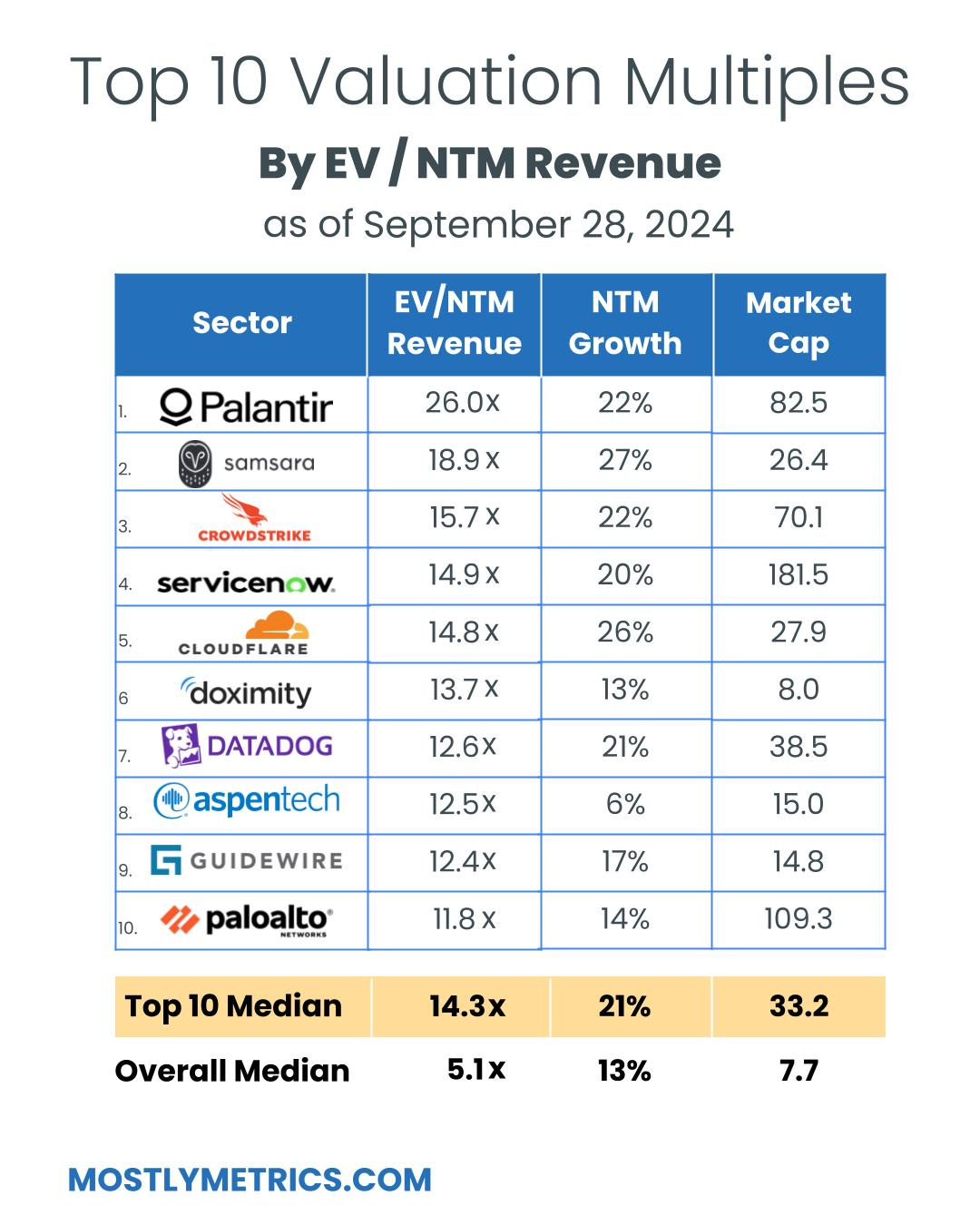
TL;DR: Multiples are UP week-over-week.
Top 10 Medians:
-
EV / NTM Revenue = 14.3x (+0.3x w/w)
-
CAC Payback = 17 months
-
Rule of 40 = 51%
-
Revenue per Employee = $502K
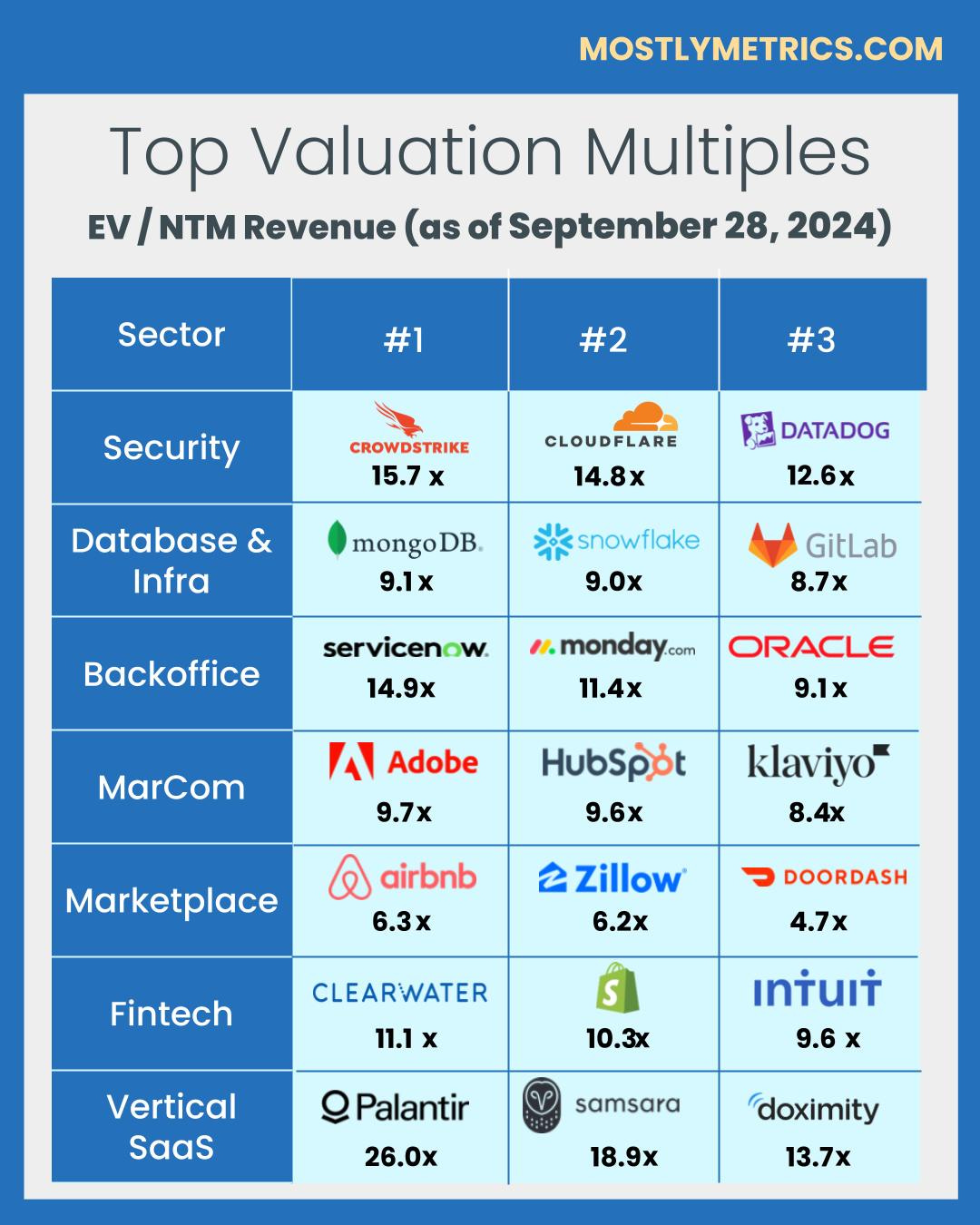
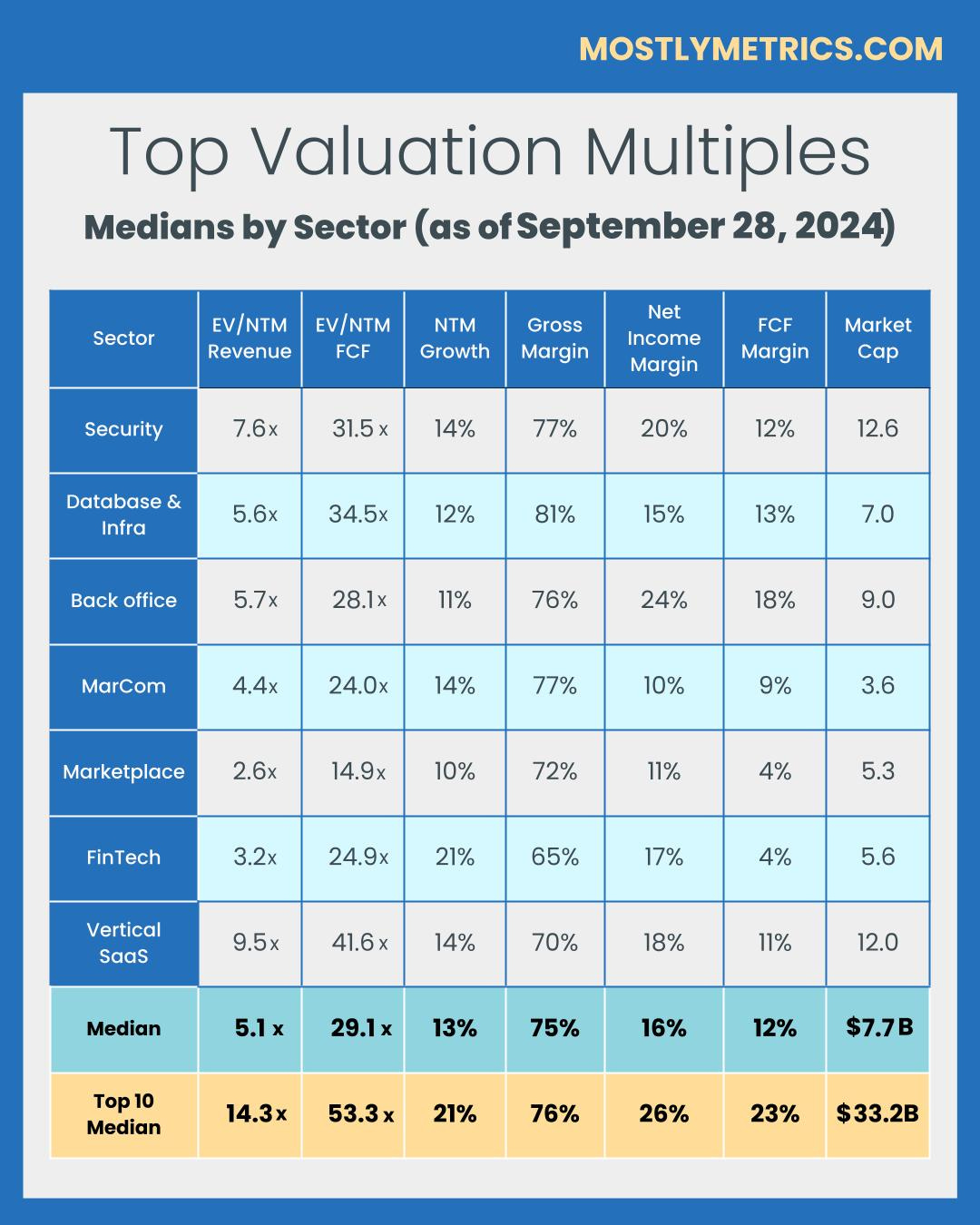
-
Figures for each index are measured at the Median
-
Median and Top 10 Median are measured across the entire data set, where n = 109
-
Population Sizes:
-
Security: 17
-
Database and Infra: 14
-
Backoffice: 15
-
Marcom: 16
-
Marketplace: 15
-
Fintech: 16
-
Vertical SaaS: 16
-
-
If you’d like the company level metrics used in these reports, upgrade to paid and you can download the excel sheet at the bottom of this post
Revenue Multiples
Revenue multiples are a shortcut to compare valuations across the technology landscape, where companies may not yet be profitable. The most standard timeframe for revenue multiple comparison is on a “Next Twelve Months” (NTM Revenue) basis.
NTM is a generous cut, as it gives a company “credit” for a full “rolling” future year. It also puts all companies on equal footing, regardless of their fiscal year end and quarterly seasonality.
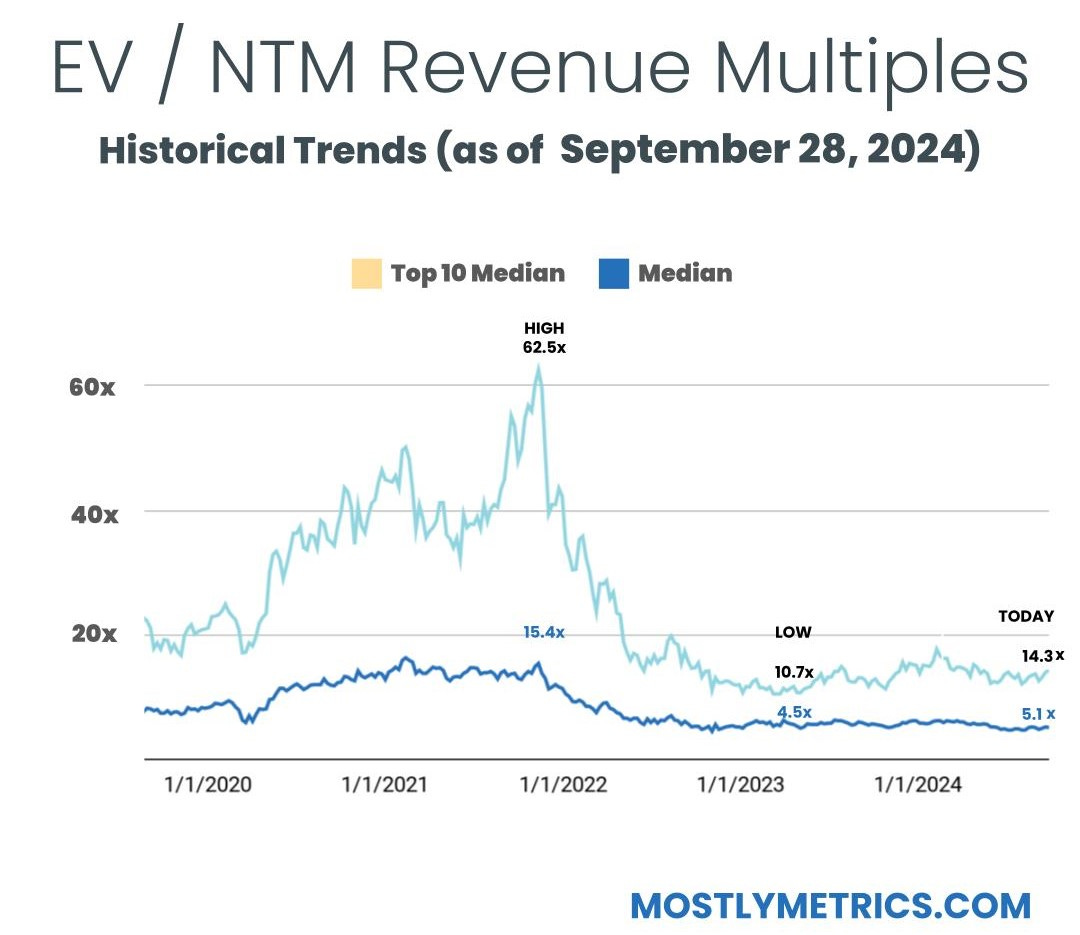
However, not all technology sectors or monetization strategies receive the same “credit” on their forward revenue, which operators should be aware of when they create comp sets for their own companies. That is why I break them out as separate “indexes”.
Reasons may include:
-
Recurring mix of revenue
-
Stickiness of revenue
-
Average contract size
-
Cost of revenue delivery
-
Criticality of solution
-
Total Addressable Market potential
From a macro perspective, multiples trend higher in low interest environments, and vice versa.
Multiples shown are calculated by taking the Enterprise Value / NTM revenue.
Enterprise Value is calculated as: Market Capitalization + Total Debt – Cash
Market Cap fluctuates with share price day to day, while Total Debt and Cash are taken from the most recent quarterly financial statements available. That’s why we share this report each week – to keep up with changes in the stock market, and to update for quarterly earnings reports when they drop.
Historically, a 10x NTM Revenue multiple has been viewed as a “premium” valuation reserved for the best of the best companies.
Efficiency Benchmarks
Companies that can do more with less tend to earn higher valuations.
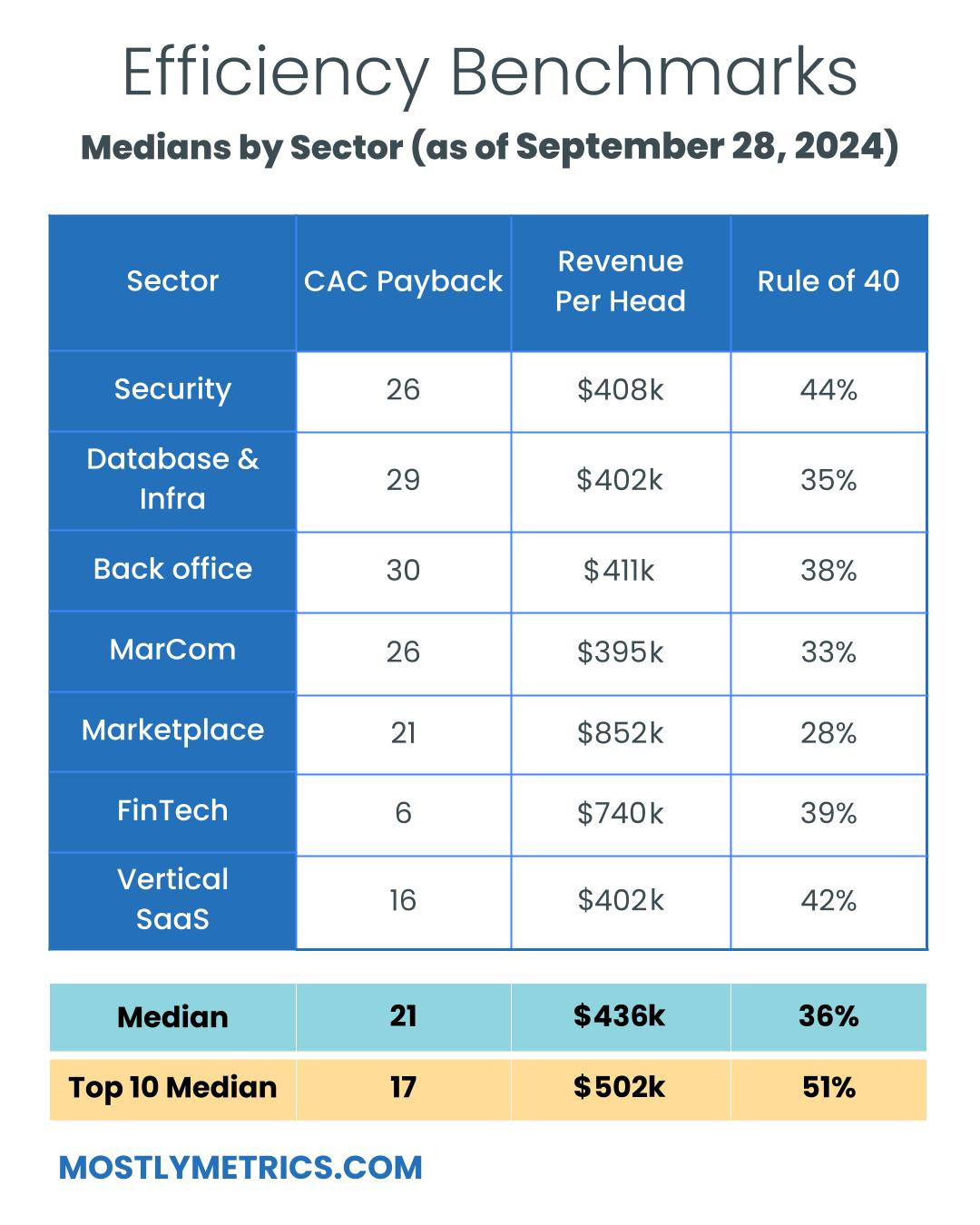
Three of the most common and consistently publicly available metrics to measure efficiency include:
-
CAC Payback Period: How many months does it take to recoup the cost of acquiring a customer?
CAC Payback Period is measured as Sales and Marketing costs divided by Revenue Additions, and adjusted by Gross Margin.
Here’s how I do it:
Sales and Marketing costs are measured on a TTM basis, but lagged by one quarter (so you skip a quarter, then sum the trailing four quarters of costs). This timeframe smooths for seasonality and recognizes the lead time required to generate pipeline.
Revenue is measured as the year-on-year change in the most recent quarter’s sales (so for Q2 of 2024 you’d subtract out Q2 of 2023’s revenue to get the increase), and then multiplied by four to arrive at an annualized revenue increase (e.g., ARR Additions).
Gross margin is taken as a % from the most recent quarter (e.g., 82%) to represent the current cost to serve a customer
-
Revenue per Employee: On a per head basis, how much in sales does the company generate each year? The rule of thumb is public companies should be doing north of $450k per employee at scale. This is simple division. And I believe it cuts through all the noise – there’s nowhere to hide.
Revenue per Employee is calculated as: (TTM Revenue / Total Current Employees)
-
Rule of 40: How does a company balance topline growth with bottom line efficiency? It’s the sum of the company’s revenue growth rate and EBITDA Margin. Netting the two should get you above 40 to pass the test.
Rule of 40 is calculated as: TTM Revenue Growth % + TTM Adjusted EBITDA Margin %
A few other notes on efficiency metrics:
-
Net Dollar Retention is another great measure of efficiency, but many companies have stopped quoting it as an exact number, choosing instead to disclose if it’s above or below a threshold once a year. It’s also uncommon for some types of companies, like marketplaces, to report it at all.
-
Most public companies don’t report net new ARR, and not all revenue is “recurring”, so I’m doing my best to approximate using changes in reported GAAP revenue. I admit this is a “stricter” view, as it is measuring change in net revenue.
Operating Expenditures
Decreasing your OPEX relative to revenue demonstrates Operating Leverage, and leaves more dollars to drop to the bottom line, as companies strive to achieve +25% profitability at scale.
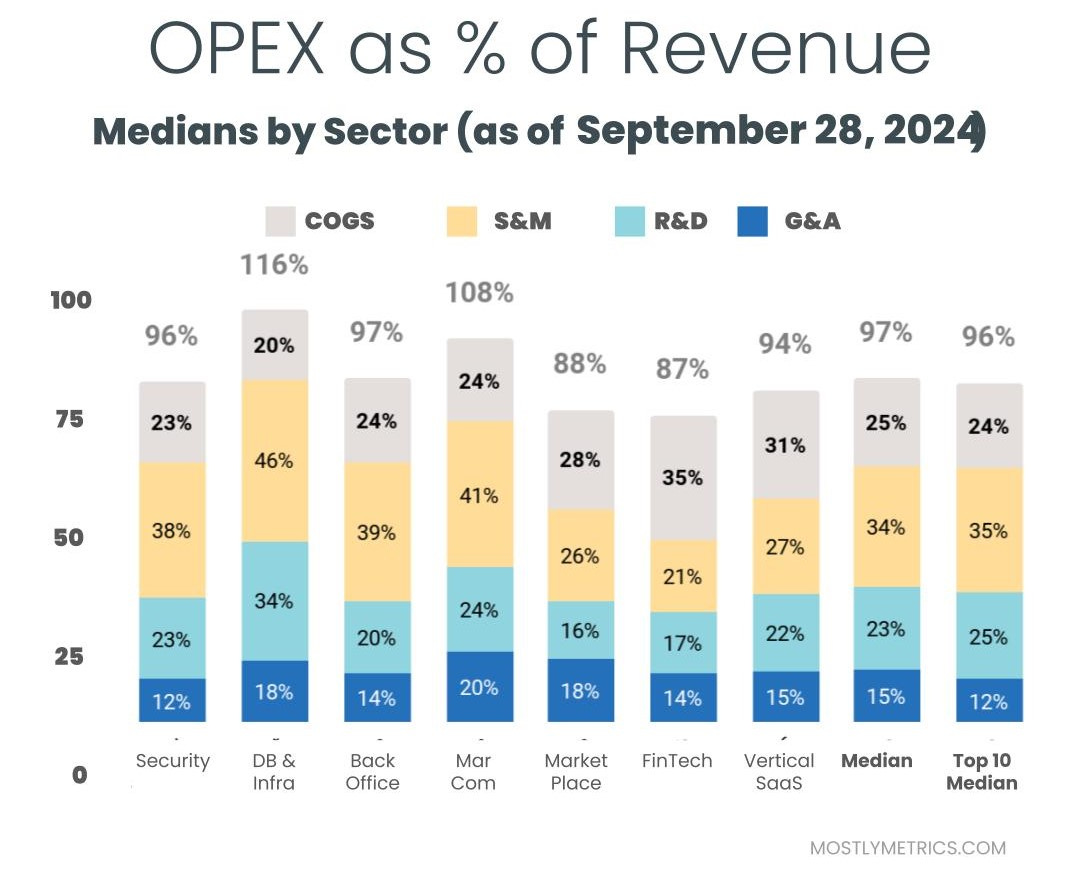
The most common buckets companies put their operating costs into are:
-
Cost of Goods Sold: Customer Support employees, infrastructure to host your business online, API tolls, and banking fees if you are a FinTech.
-
Sales & Marketing: Sales and Marketing employees, advertising spend, demand gen spend, events, conferences, tools
-
Research & Development: Product and Engineering employees, development expenses, tools
-
General & Administrative: Finance, HR, and IT employees… and everything else. Or as I like to call myself “Strategic Backoffice Overhead”
All of these are taken on a Gaap basis and therefore INCLUDE stock based comp, a non cash expense.
Want to build your own comp set?

Upgrade to paid to download the company level workbook.
Read more




